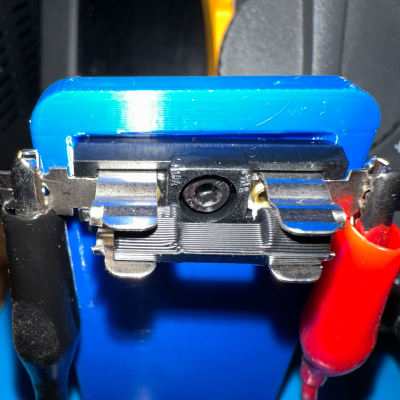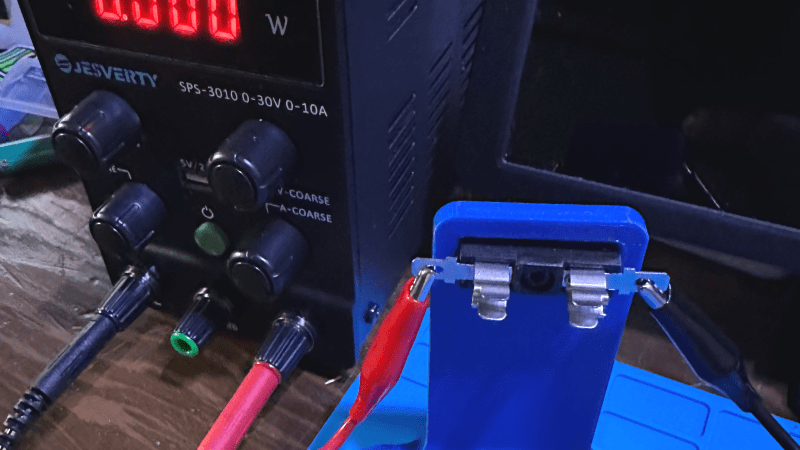Everything is a fuse if you run enough current through it. Or at least [JohnsonFarms.us] seems to think so, which has led him to design 3D-printed fuses made from conductive PLA filament.

In theory a 3D printed fuse works the same as a normal one: excessive current draw will cause the conductive plastic to briefly become a heater, causing it to self-destruct and break the electrical connection. There’s a risk of melted plastic and perhaps a nonzero combustion risk, but [JohnsonFarms.us] is less interested in whether this is a good idea and more interested in whether it can work at all, and with what degree of predictability and/or regret.
His experiments so far show that printed fuses are essentially meltable resistors with values between 300 Ω and 1250 Ω, depending on shape. What it takes to bring those to roughly 60 °C, where PLA softens, and around 150 °C, where PLA melts, is next on the to-do list.
Whatever conclusions are reached, it is interesting to think of conductive filament as a meltable resistor, and ponder what unusual applications that might allow.
Most conductive filaments have high resistance, but not all. Some, like Electrifi by Multi3D, have extremely low resistance and were used in a project that made 3d-printed logic gates.

















There are some basic requirements for fuses:
1) Must break the circuit before wiring or other components in circuit catch fire.
2) Must not break the circuit under short-term minor overload (“in-rush” or starting current).
2) Must break the circuit rapidly on severe overloads.
3) Must not catch on fire or ignite nearby materials.
4) Must not degrade over a long period at the rated current.
5) Must add as little resistance as possible, to avoid excessive voltage drop in normal operation.
6) Must not arc over at the rated voltage, even under severe overload.
From what I can see, this probably doesn’t meet any of these. On the other hand, I’ve seen actual fuses for sale that consist of a 1/10 Watt resistor held by a spring in tension, so I could be wrong.
This is obviously not the kind of fuse that prevents things from blowing up. (Sometimes English is a really silly language.)
Well if you packed it in a tube of potassium nitrate powder, like an HRC fuse, the fuse action might be more predictable.
Agree. I can’t imagine a piece of conductive plastic solving any real world fuse applications.
The fuses with the resistor and springs are (in my experience) “slow-blow” fuses, which take a little longer to blow open than standard fuses. Not sure if the resistor is actually part of the fuse, or just used for timing.
I’m not sure what their normal use case would be, but I would guess they are used to protect sensitive electronics that might be easily damaged.
They’re used for motors and other loads that have large but brief starting currents. For example you may wish to limit a motor to 10A but allow for a 50A, 250 millisecond startup current.
Maybe it could be used to fuse parts together by embedding a heating element along the seam.
Annoying battery doors that let you put the batteries (not supplied) in, then weld themselves closed the first time you turn it on.
Oh that’s an interesting idea, I like that.
“Connection established. Make permanent?”
user clicks yes out of curiosity
connector welds itself to the enclosure
I had an EE professor that used to say “remember, anything can be a fuse.” Just before blowing up various things: resistors, capacitors, diodes, etc. I seem to recall it was the lecture on lab safety.
Old auto-tech instructor I know who teaches about automotive electronics always starts his course with the phras:
“Remember, anything can be a fuse. You just need to be able to slam enough current through it, and for it to be the weakest link in the circuit.”
100,000 Amp fuse?
Note attached to piece of 1/4 inch copper tube found in customer’s boat’s fusebox.
A thin strand would be easier to break the current with when it melts, but the decrease in mass would probably increase the thermal loss due to the surface area ratio. Making a coil would solve that, but be slower to break the circuit upon melting, possibly be tricky to print too. Maybe a single filament coated with nonconductive insulation of a lower melting point.
I’m also now wondering about making a 3d printed bimetallic strip or even one of those wax motor thermal sensors. Perhaps something like a cigarette lighter element infilled with flexible filament that could expand and contract due to thermal expansion, maybe with some sort of lever to form a circuit breaker.
How good of an electromagnet could be 3d printed, how low a resistance.